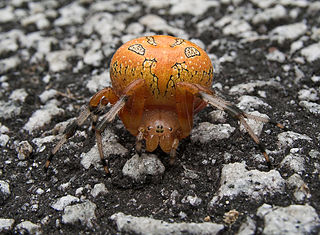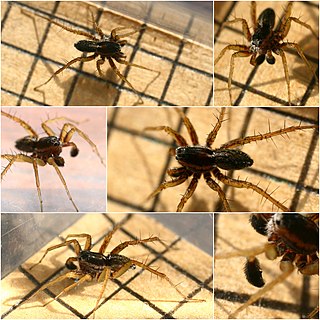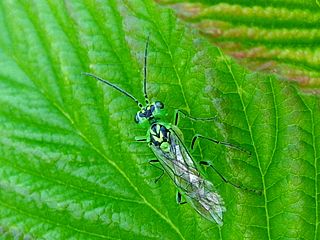
Sawflies are the insects of the suborder Symphyta within the order Hymenoptera, alongside ants, bees, and wasps. The common name comes from the saw-like appearance of the ovipositor, which the females use to cut into the plants where they lay their eggs. The name is associated especially with the Tenthredinoidea, by far the largest superfamily in the suborder, with about 7,000 known species; in the entire suborder, there are 8,000 described species in more than 800 genera. Symphyta is paraphyletic, consisting of several basal groups within the order Hymenoptera, each one rooted inside the previous group, ending with the Apocrita which are not sawflies.

Wasps in the family Pompilidae are commonly called spider wasps, spider-hunting wasps, or pompilid wasps. The family is cosmopolitan, with some 5,000 species in six subfamilies. Nearly all species are solitary, and most capture and paralyze prey, though members of the subfamily Ceropalinae are kleptoparasites of other pompilids, or ectoparasitoids of living spiders.

Helianthemum apenninum, the white rock-rose, is a white-flowering rock rose of the family Cistaceae found in the North Atlantic region, mainly in dry grassy and rocky places across large parts of Europe.

Xiphydriidae are a family of wood wasps that includes around 150 species. They are located all over the world including North and South America, Australia, Europe, and others. Xiphydriidae larvae are wood borers in dead trees or branches of a range of trees. They are characterized as having long and skinny necks with dome-shaped heads. The oldest fossils of the group are from the mid Cretaceous.

Tenthredinidae is the largest family of sawflies, with well over 7,500 species worldwide, divided into 430 genera. Larvae are herbivores and typically feed on the foliage of trees and shrubs, with occasional exceptions that are leaf miners, stem borers, or gall makers. The larvae of externally feeding species resemble small caterpillars. As with all hymenopterans, common sawflies undergo complete metamorphosis.
The National Biodiversity Network (UK) (NBN) is a collaborative venture set up in 2000 in the United Kingdom committed to making biodiversity information available through various media, including on the internet via the NBN Atlas—the data search website of the NBN.

Araneus marmoreus, commonly called the marbled orbweaver, is a species of spider belonging to the family Araneidae. It is sometimes also called the pumpkin spider from the resemblance of the female's inflated abdomen to an orange pumpkin. It has a Holarctic distribution.

Pardosa nigriceps is a species of wolf spider in the family Lycosidae. This European spider is common on heaths and open spaces where there is low vegetation and bushes. The males have characteristically black palps due to a thick covering of hair. Males are 4-5mm in size the females are bigger at 5-7mm with a larger abdomen.

Arge cyanocrocea, the bramble sawfly, is a species of sawflies of the family Argidae, subfamily Arginae.

Solva marginata, also known as the drab wood-soldierfly, is a species of soldier fly in the family Xylomyidae, the "wood soldier flies".

Rhogogaster chlorosoma is a species of sawflies in the family Tenthredinidae.

Abia sericea, common name club horned sawfly or scabious sawfly, is a species of sawflies belonging to the family Cimbicidae.

Rhogogaster punctulata is a species of sawflies in the family Tenthredinidae.

Hemichroa crocea, the striped alder sawfly or banded alder sawfly, is a species of sawfly in the family Tenthredinidae. It is probably native in Europe and has been introduced to North America. The larvae feed on the foliage of several species of alder and sometimes on birch, hazel and willow.

Diprion similis is a species of sawfly in the family Diprionidae. It is native to central and northern Europe and Asia but was accidentally introduced into North America where it has become invasive. The larvae feed on the needles of pine trees, especially those of the white pine. In North America it is known as the introduced pine sawfly or the imported pine sawfly. It is also known as the white pine sawfly because of its preference for feeding on the white pine, but this name is confusing because another sawfly, Neodiprion pinetum, whose larvae also feed on this tree, is itself known as the "white pine sawfly".

Euura atra is a species of sawfly belonging to the family Tenthredinidae. The larvae feed internally on the shoots of willows and do not usually form galls, although it is included in plant gall literature such as British Plant Galls. It was first described by Louis Jurine in 1807. E. atra is one of a number of closely related species known as the Euura atra subgroup.

Salix repens, the creeping willow, is a small, shrubby species of willow in the family Salicaceae, growing up to 1.5 metres in height. Found amongst sand dunes and heathlands, it is a polymorphic species, with a wide range of variants. In the UK, at least, these range from small, prostrate, hairless plants at one end of the spectrum to taller, erect or ascending silky-leaved shrubs at the other. This wide variation in form has resulted in numerous synonyms.

Tenthredo crassa is a sawfly species belonging to the family Tenthredinidae.

Rhyacionia logaea, the Elgin shoot moth, is a species of moth belonging to the family Tortricidae, and used to be considered a subspecies of Rhyacionia duplana, the summer shoot moth, but is currently recognized as its own species. It has two similar sister species, which are Rhyacionia duplana duplana and Rhyciaonia duplana simulata. Its discovery is attributed to English entomologist John Hartley Durrant, F.E.S., who contributed his findings of the species R. logaea and R. duplana to the Trustees of the British Museum in 1911. The Elgin shoot moth is considered to be a micro-moth.


















